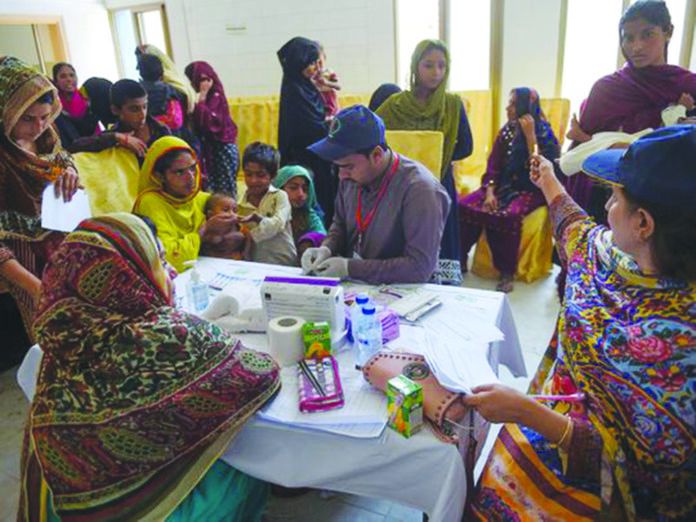In the heart of Rato Dero, Sindh, a mother’s anguish echoes as her 10-year-old daughter, Amna, battles HIV. The stigma surrounding the virus has not only taken a toll on their lives but has also forced the family to move homes three times.
Amna’s journey with HIV began at the tender age of six, marked by persistent weakness and recurrent fevers. A routine checkup during the Rato Dero outbreak revealed the harsh truth – Amna was diagnosed with HIV. For her mother, it felt like the sky had collapsed.
We are middle-class people, but still, we changed three houses because of this,” the mother laments, highlighting the harsh reality faced by families dealing with HIV in a society rife with misunderstanding and prejudice.
The National AIDS Control Program Pakistan reports a staggering 21,344 registered HIV/AIDS patients in Sindh, with 10,592 cases in Karachi alone. Among them, 2,470 are children, illustrating the urgent need for awareness and intervention.
Sindh witnessed a surge in child HIV cases in 2019 during the Ratodero outbreak, with over 900 children testing positive. The Tehsil Headquarters Hospital Ratodero remains a focal point, with 528 girls and 850 boys registered. Larkana follows closely, with 508 children registered in Sheikh Zayed Children’s Hospital.
The virus’s rampant spread is attributed to unsafe medical practices, including the reuse of surgical instruments, needles, and blood transfusions. Alarming data from the Pakistan Medical and Dental Association reveals that approximately 40% of the two lakh dentists in Sindh, among the six lakh across the country, operate in major cities, contributing to the risk of HIV transmission.
Beyond the statistics, the narrative of Amna’s family emphasizes the pressing need for societal empathy and understanding. The mother’s poignant words capture the isolation and hardships faced by families dealing with HIV, urging society to move beyond stereotypes and offer support.
As the number of HIV cases continues to rise, it is crucial to prioritize education and awareness campaigns, dispelling myths and reducing the stigma associated with the virus. Communities must come together to support affected families, fostering an environment of compassion and understanding.
To combat stigma effectively, grassroots campaigns should be launched, involving local leaders, religious figures, and influencers. These campaigns can target schools, community centers, and religious institutions to promote accurate information about HIV transmission and prevention.
The urgency of the situation cannot be overstated. The National AIDS Control Program’s data paints a stark picture of the prevalence of HIV in Sindh, particularly among children. The government, non-governmental organizations, and international partners must collaborate to implement comprehensive intervention strategies.
Healthcare Infrastructure and Preventive Measure in the fight against HIV, the role of healthcare professionals is pivotal. Strengthening healthcare infrastructure, ensuring safe medical practices, and promoting regular screenings are essential steps in curbing the spread of the virus.
The focus should be on upgrading medical facilities, especially in regions where the prevalence of HIV is high. This includes training healthcare workers on infection control measures and ensuring the availability of sterile equipment. Regular monitoring and evaluation of healthcare practices can help identify and rectify potential sources of infection. Preventive measures should be a cornerstone of public health initiatives. This involves not only educating the public on safe practices but also implementing policies that enforce infection control in healthcare settings. Strict regulations and oversight can significantly reduce the risk of HIV transmission through medical procedures.
The Human Face of Statistics Amna’s story serves as a powerful reminder that behind every statistic is a human face, a family grappling with the impact of a life-altering diagnosis. It is the collective responsibility of society, healthcare providers, and policymakers to work collaboratively towards creating a more inclusive and supportive environment for those living with HIV in Sindh and beyond.
In conclusion, the silent struggle of living with HIV in Sindh, Pakistan, demands immediate and sustained attention. The intersection of societal stigma, inadequate healthcare infrastructure, and specific challenges faced by vulnerable communities creates a complex web that must be untangled through comprehensive and collaborative efforts.
It is a call to action for governments, healthcare professionals, NGOs, and communities to unite in their commitment to creating a society where individuals living with HIV are not only medically supported but also embraced with compassion and understanding. Only through such collective efforts can we hope to build a future where stories like Amna’s become tales of resilience and triumph over adversity.






















